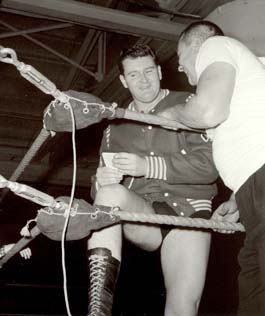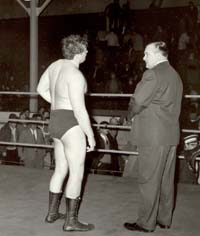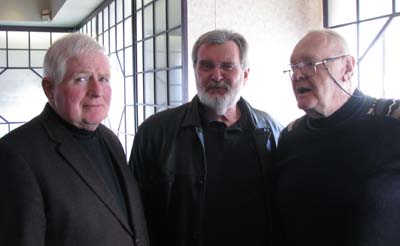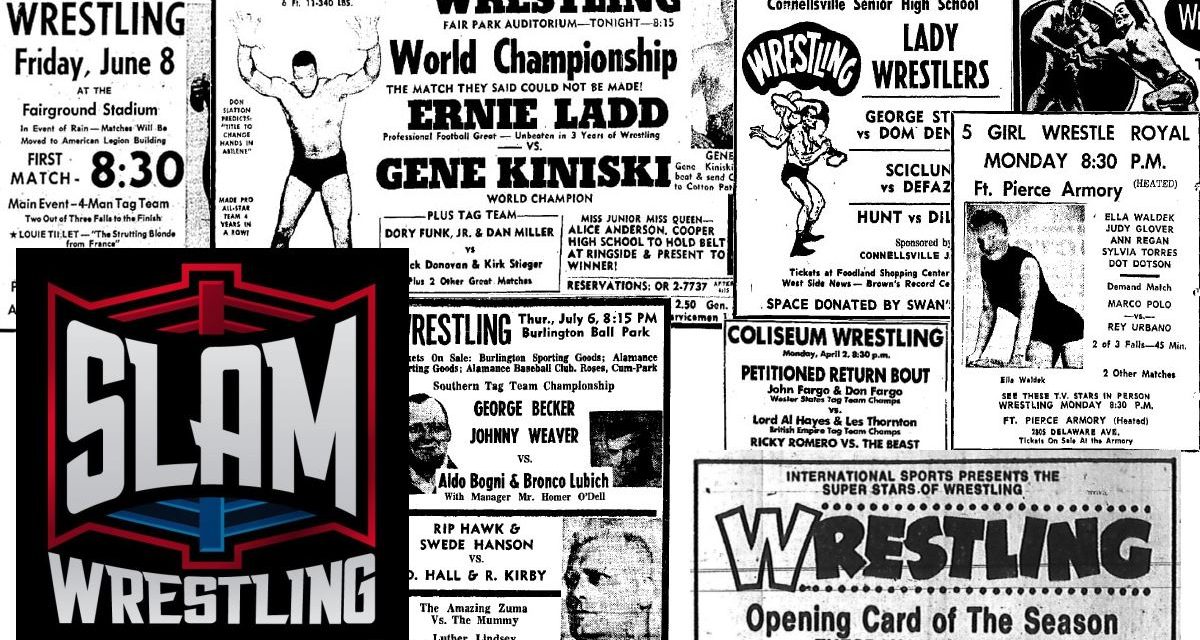Murray Cummings, a southern Ontario-based wrestling star from the 1960s, was considered a great, agile athlete in the ring, but never a shooter. But you can’t say that about him now.
Cummings, who retired from professional wrestling in the early 1970s, is passionate about the Cowboy Action Shooting.
The C.A.S. has been around a quarter century and is made up of more than 100,000 people who dress in costumes from the time period and shoot at steel targets for speed and accuracy.

Murray Cummings at the Hamilton Forum in April 1966. Photo by Roger Baker.
“It’s a lot of fun and I’m completely dedicated to this. I run matches almost 12 months of the year now. It’s just great,” Cummings recently told SLAM! Wrestling. “It’s never too late to have a happy childhood.”
He was born January 11, 1942 in Hamilton, with his father a machinist and his mother at home. Growing up, the 6-foot-2 Cummings wasn’t into cowboys as much as he was basketball and football at Hillpark High School. His passion for weightlifting started as a teen. Though Cummings never wrestled amateur, he did love to watch the pros.
The Municipal Pool in Hamilton, where weekly matches would take place over the water, was a cool place to go see wrestling, said Cummings.
“I used to go swimming there at the Municipal Swimming Pool, and they put the ring in, and they had a ramp, very similar to what they had at Maple Leaf Gardens, when they used to have shows there,” he remembered. “The ramp went out to the ring, and they’d walk out the ramp, get in the ring and do their thing. It was fabulous because they milked the crowd so well because everybody wanted to see somebody go into the water. Well, I never saw anybody go in — I was only there two, three times.”
Out of high school, Cummings was signed as a prospect for the Hamilton Tiger-Cats of the Canadian Football League. He only got to play in the exhibition games.
“When they cut me, it was interesting, but this is not an unique story from football, but I was 19 years old, maybe 20. When I was cut, I found they had waived me out of the league, put me on waivers, and they listed my age as 29. Of course, the reason they did that is they didn’t want me to be picked up by any other club, because who wants a 29-year-old rookie?” he surmised.
A few of his friends were trying out for the Eskimos in Edmonton, and Cummings was offered a tryout. But there was a hitch — the Ti-Cats held his territorial rights since he was a local boy and he wasn’t yet 21; the club wouldn’t release him. He ended up with the semi-pro Hamilton Hurricanes.
“I played a couple of years of junior football, and I always had my eye on the wrestling business, because I was big, and I got onto the weights and everything. I got up to 275 at one time,” Cummings said. “Then I played ball starting at that, and then I went back down to about 240, which I mostly maintained when I was in the business. I didn’t trust football, obviously, from what happened. And I was looking very askew at the wrestling business too, because there was a lot of bullshit involved.”
Hamilton was notorious as “The Factory” — a working-class city that had sent hundreds of men into the wrestling game. Two gyms in the city catered to those who wanted to get in shape and learn about wrestling: Spittles’ Gym and Wentworth’s.
Cummings said that Al Spittles was rude to him, and he didn’t feel that he could learn anything else from Spittles or benefit from the gym.
“I left and went to Jack Wentworth’s gym. I said, ‘I want to learn to wrestle. How much is it going to cost?’ Because Spittles wouldn’t give me a straight answer. He wouldn’t tell me how much and he wouldn’t tell me how long it would take. ‘Oh, we like to bring our people along slow.’ It was a lot of kayfabe, right? I thought it was ridiculous. Anyway, Wentworth was straight. He said, ‘You’re already big enough. If you catch on quick, a couple of months.’ Basically, that was it. I started working there. I worked with Duncan McTavish (Matt Gilmore); he showed me a lot when I started.”
“He was a good learner, I’ll tell you that,” McTavish recalled of Cummings. “You could tell from the time you went into the ring with him that he had it. Some guys, you go in there, and their feet are in the wrong place, they’re never on balance or anything. With him, everything was on balance, whether that was from football or not, I don’t know. But he was balanced. When you’ve got somebody who’s got balance, you can start teaching.”
“Jack was the primary trainer,” continued Cummings. “Having watched for so long, because I watched it when I was a kid — everybody watched wrestling when I was growing up. I knew all the moves, I’d just never done them. Then when I found out really how loose everybody was …”
Cummings was never actually “smartened up” to the business, but figured it out pretty quickly.
“I worked with everybody that was down at Jack Wentworth’s at the time. I picked up things as I went along,” he said. “I was 240 and I had reasonably good athletic ability. When I first went in there, I could do a nip-up. I’d practised all of that stuff since I was about 13 years old. I watched the guys do it, I thought, ‘I could do that,’ and I learned to do it. I came on pretty quickly. Jack was pretty straight with me. He never tried to send me off to Tennessee or places where other guys went because I had a good job and he knew I wasn’t eager to give it up for empty promises. ”
Throughout his wrestling career, and in fact up until 14 years ago, Cummings worked at Dofasco, one of the big steel foundries in Hamilton. He worked in production planning and control as a manager, and still runs a side contracting business with Dofasco.
Early in his career, Cummings was sent to Pittsburgh to work as enhancement talent. During a match with Baron Gattoni, Cummings went flying after a beale.
“Well, I could really go high. I was a good dropkicker, I had good spring and everything. I took a beale and I went really high. He helped me a little bit, but I was up above his head, as I turned over and came down and did a perfect eight-point landing on the mat. Well, when Bruno Sammartino saw that, he was getting ready to work a program with this guy. He wanted me back the next week because he wanted to work with me on TV, to beale higher. He said, ‘I’ve never seen anybody take a beale that high.’ I said, ‘Well, I can go higher if you can stay out of my way and help me, give me a push.’ He bealed me twice on this thing, and everybody was oohing and aahing. I was good at it. I almost hit the lights in this TV studio. Sammartino is just as pleased as anything. He wanted me to go with them, and I wouldn’t. … It was shortly after that that Wentworth took me to Frank Tunney.”
Getting an in with Toronto promoter Frank Tunney, was “unusual,” said Cummings, “but I guess he recognized that I had some talent.”
Tunney would use Cummings around southern Ontario, and share him with promoters he worked with. “I traveled for Frank. He would send me to Montreal, and St. Louis, and to Florida. But I always did it on time off, or take a week’s holiday. I worked for The Sheik in Detroit.”
Working for Tunney meant working with Whipper Billy Watson, a Canadian icon on the downside of his career. But Watson wasn’t stupid, and knew when to latch on to a young star.

Murray Cummings listens to advice from Whipper Billy Watson. Photo by Roger Baker.
“I’ll tell you the first time I met Whipper Billy Watson,” he promised. “They used me on television for a year, never put me on a house show. I was beating people two, three times a week. They had CBC wrestling, wrestling on CFTO, and wrestling on Channel 11. They would pretty much book me on all of those TV shows. I would be win, win, win, win, win. They were really putting me over. So I remember being at Channel 9, CFTO, in Agincourt. Actually I think I was working with Willie Farkus, The Wolfman. I was working with him, and he was going to put me over or whatever. The match was over and I was being interviewed by Lord Athol Layton.
“I was standing there doing the interview, and someone came up on my left side. I looked and it’s Whipper Watson, all decked out in a suit. He says, ‘Oh, Lord Athol, sorry for interrupting, but I just want everybody to know that Murray here is my protege and I’ve been training him at my farm up in Keswick, blah, blah, blah.’ Arm around my shoulder. So I twigged right away, ‘Yeah, Whip, thanks very much. I really appreciate it, blah, blah.’ The interview was over, we walked back into the dressing room, and he had a few words to say to me, and away he went. That was it.
“Next thing I know I’m his tag team partner — everywhere. … I thought, ‘This is fine.’ I did it for a couple of years. When he was around and in a tag team, I was his partner, and I would go in and sell and sell and try to get to him. He’d come in and do the highspot and the finish and everything. I was taking their money, so I did what they wanted. That was fine. It was fun. I never minded that, but I never trusted them.”
Cummings wasn’t one to let fame go to his head.
“They told me I was Rookie of the Year in 1965,” he said with a laugh. Pat Flanagan was the announcer on Channel 11 when Watson and Cummings were teaming. “All he talked about was, ‘Murray Cummings is Rookie of the Year blah blah blah in the National Wrestling Alliance.’ I’m hearing all of this stuff, but all it was was talk. But I was a little flattered. It was all good. I always remember that because it meant absolutely nothing.”
Besides his real name, Cummings was one of the Assassins with Jack Hill (Jerry Valiant, The Stomper, etc.), and as Flash Gordon in Detroit.
“That was so embarrassing. They wanted me to go down and they wanted me to wear a hood. I said, ‘Fine, I’ll come in.’ When I went in, they told me what the gimmick was, and I just shook my head: ‘These guys are crazy. It’s just so stupid.’ And anyway, I did it,” he said about being introduced as being from Mars.
During a road trip around Michigan, Cummings traveled with manager Louis Papineau and his charge, The Student, who was Jim Myers under a mask — and who would later become George “The Animal” Steele.
“George and I are in the back, and we’re talking, because we have a similar background, we both played football and whatnot, and we’re both just starting in the business. Later, when we were in Detroit together, he was still The Student, and I was Flash Gordon, so they teamed us up,” Cummings recalled. “They worked a program for whatever length of time. Then they decided they wanted me to go babyface. So we had a falling out during a match, the usual stuff. They booked us together and he unmasked me, illegally of course.”

Ernie “The Executioner” Moore, Murray Cummings and Hurricane Smith (Bob Grimbly) at a gathering of Hamilton oldtimers in December 2009. Photo by Greg Oliver.
Following that stint, Cummings formed a successful and popular team with Dewey Robertson.
“If I had to say anything, I’d say Murray was a better partner,” said longtime fan Terry Dart. “Murray had one hell of a ring style. He had a dropkick similar to Pat O’Connor.”
Cummings abruptly stopped wrestling around 1972.
“I got hurt, my knees,” he explained. “What screwed my knees up were bad rings. You’d be running or something in the ring and hit a hole, and down you’d go.”
He never really thought he’d be in wrestling long term, understanding that a sporting career is very short compared to one’s whole life. “I believed it. That’s why I would never just give up everything and leave my family at home and go on the road,” Cummings said.
It was pretty straightforward putting wrestling behind him. “I just moved on,” he said. His family was still young when he quit, and they moved to the country outside Hamilton, where they lived on a farm with horses, snowmobiles, motorcycles. “I always kept busy doing something,” he said. Cummings has a son and daughter from his first marriage, and a stepdaughter from his second. “I’m still close to my family — even my ex-wives!” he laughed.
Murray Cummings is one of those wrestlers that many think could he have gone further. Having always kept the day job, he doesn’t disagree.
“Sometimes I did, and other times I thought no. Athletically, I think I was as good as anybody I worked with — and I worked with guys like Dory Funk Jr., Bruno, all of the people in Detroit, Hans Schmidt and I worked plenty of times together. I could hold my own with all of those people. Where I knew that I really wouldn’t make it was, I wasn’t very good on the mic, the interviews. I was very straightforward and all that. I didn’t have any of that flamboyant kind of stuff, the colour. I thought I was a little colourless compared to other people. Athletically, I thought I was as good as anybody.
“I wouldn’t have made a world champion, because I didn’t have that special thing. I knew that.”
But, though it’s a cliché, he’s okay with the way it all happened.
“I don’t regret any of it, being involved in the business, but I was always careful about the business.”

